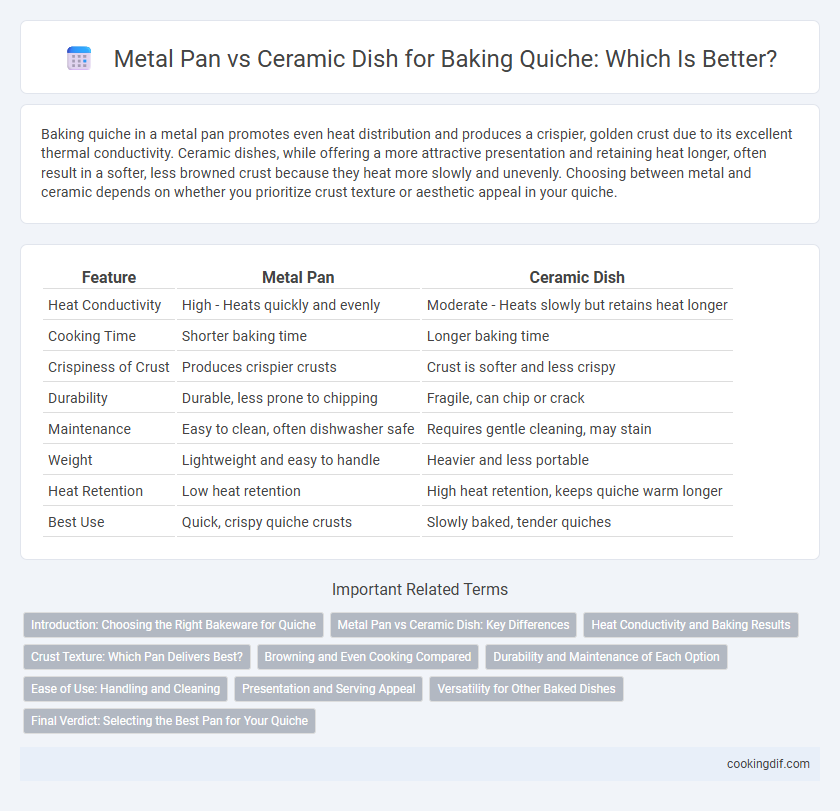Baking quiche in a metal pan promotes even heat distribution and produces a crispier, golden crust due to its excellent thermal conductivity. Ceramic dishes, while offering a more attractive presentation and retaining heat longer, often result in a softer, less browned crust because they heat more slowly and unevenly. Choosing between metal and ceramic depends on whether you prioritize crust texture or aesthetic appeal in your quiche.
Table of Comparison
| Feature | Metal Pan | Ceramic Dish |
|---|---|---|
| Heat Conductivity | High - Heats quickly and evenly | Moderate - Heats slowly but retains heat longer |
| Cooking Time | Shorter baking time | Longer baking time |
| Crispiness of Crust | Produces crispier crusts | Crust is softer and less crispy |
| Durability | Durable, less prone to chipping | Fragile, can chip or crack |
| Maintenance | Easy to clean, often dishwasher safe | Requires gentle cleaning, may stain |
| Weight | Lightweight and easy to handle | Heavier and less portable |
| Heat Retention | Low heat retention | High heat retention, keeps quiche warm longer |
| Best Use | Quick, crispy quiche crusts | Slowly baked, tender quiches |
Introduction: Choosing the Right Bakeware for Quiche
Metal pans conduct heat quickly and evenly, promoting a crisp, golden crust ideal for quiche. Ceramic dishes provide gentle, uniform heat, resulting in a tender, custardy filling but a less crispy crust. Selecting between metal and ceramic depends on the desired texture balance between crust and filling in your quiche.
Metal Pan vs Ceramic Dish: Key Differences
Metal pans conduct heat more efficiently than ceramic dishes, resulting in a crisper, evenly browned quiche crust. Ceramic dishes, while slower to heat, retain heat longer and provide gentle, consistent cooking that helps prevent over-baking. Choosing between metal and ceramic depends on whether a flaky texture or a tender, custardy filling is the priority for your quiche.
Heat Conductivity and Baking Results
Metal pans offer superior heat conductivity, allowing quiches to bake evenly with crisp, golden crusts and well-set fillings. Ceramic dishes retain heat longer, promoting gentle, slower cooking that yields tender, custard-like textures but may result in less browning. Choosing metal pans enhances browning and texture contrast, while ceramic dishes provide a softer, creamier quiche experience.
Crust Texture: Which Pan Delivers Best?
Metal pans conduct heat more efficiently, resulting in a crisper, evenly browned quiche crust with a golden finish. Ceramic dishes heat more slowly and retain heat longer, producing a tender, softer crust that may lack the crunch of metal. For bakers seeking a perfectly crisp quiche crust, metal pans typically deliver superior texture and consistent results.
Browning and Even Cooking Compared
Metal pans promote superior browning and crisp edges in quiche baking due to their excellent heat conductivity and even heat distribution. Ceramic dishes, while offering slower and gentler cooking, may result in less browning but provide uniform cooking without hot spots. Choosing a metal pan enhances a golden, crispy crust, whereas ceramic ensures a tender, evenly cooked quiche with a softer texture.
Durability and Maintenance of Each Option
Metal pans offer superior durability due to their resistance to chipping and cracking, making them ideal for frequent quiche baking. Ceramic dishes provide excellent heat retention but require careful handling to avoid breakage and may need more delicate cleaning to prevent surface damage. Maintenance of metal pans is straightforward with regular washing and seasoning, while ceramic dishes demand gentle handwashing to preserve their glaze and longevity.
Ease of Use: Handling and Cleaning
Metal pans offer superior ease of handling due to their lightweight nature and sturdy construction, making them simple to maneuver when transferring in and out of the oven. They conduct heat efficiently, ensuring even baking and easy release of the quiche crust without sticking. Ceramic dishes, although heavier and more fragile, provide an attractive presentation and retain heat longer, but require careful cleaning to avoid staining and chipping.
Presentation and Serving Appeal
Metal pans provide crisp, golden crusts essential for visually appealing quiches, enhancing texture contrast that pleases the palate. Ceramic dishes offer a rustic, elegant look with their smooth finish and often colorful glaze, creating an inviting presentation ideal for serving directly at the table. The choice impacts serving appeal by balancing crust quality with aesthetic charm, tailored to the dining experience.
Versatility for Other Baked Dishes
Metal pans offer superior heat conduction, making them ideal for achieving crisp, evenly browned quiche crusts and versatile enough for roasting vegetables or baking cookies. Ceramic dishes provide excellent heat retention and even cooking, perfect for delicate custards, casseroles, and gratins while maintaining moisture in quiches. Choosing between metal and ceramic depends on desired texture and the variety of baked dishes prepared, with metal favored for dishes requiring crispness and ceramic for gentle, uniform baking.
Final Verdict: Selecting the Best Pan for Your Quiche
Metal pans conduct heat efficiently, producing a crisp, golden crust ideal for quiche. Ceramic dishes offer even heat distribution and retain warmth longer, which is perfect for a tender, evenly baked filling. Choosing a metal pan enhances crust texture, while ceramic ensures gentle cooking, making the best choice dependent on your preferred quiche consistency.
Metal pan vs ceramic dish for baking Infographic

 cookingdif.com
cookingdif.com